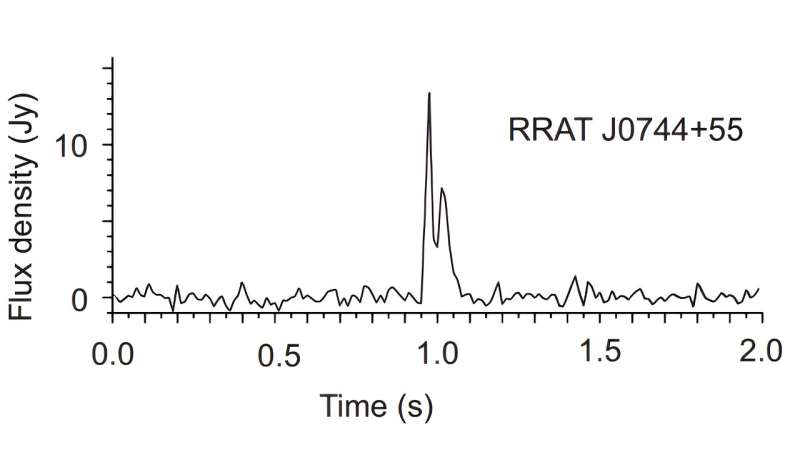September 13, 2023 report
This article has been reviewed according to Science X's editorial process and policies. Editors have highlighted the following attributes while ensuring the content's credibility:
fact-checked
preprint
trusted source
proofread
Two new rotating radio transients discovered

Using the Large Phased Array (LPA) radio telescope of the Lebedev Physical Institute (LPI) in Pushchino, Russia, astronomers have detected two new rotating radio transients (RRATS). The finding is reported in a research paper published September 2 on the pre-print server arXiv.
RRATs are a subclass of pulsars characterized by sporadic emission. First objects of this type were identified in 2006 as sporadically appearing dispersed pulses, with frequencies varying from several minutes to several hours. However, the nature of these transients is still unclear. In general, it is assumed that they are ordinary pulsars that experience strong pulses.
So far, only slightly more than 100 RRATs have been found, therefore astronomers are interested in detecting more transients of this type in order to characterize them and improve our knowledge about their nature.
Now, a team of astronomers led by Vladimir Samodurov of National Research University in Moscow, Russia, reports the discovery of two new objects of this class—J0249+52 and J0744+55. The new RRATS were detected as a result of 10 months of LPA observations recorded in six frequency channels with a channel width of 415 kHz and a total bandwidth of 2.5 MHz.
"It turned out that the found pulses belong to four known pulsars and two new rotating radio transients," the researchers wrote in the paper.
J0249+52 and J0744+55 were found to have dispersion measures of about 27.5 and 10.5 pc/cm3, respectively. J0249+52 has an estimated peak flux density between 16.5 and 29.0 Jy, while in the case of J0744+55 it is between 18.8 and 15.5 Jy.
The collected data was not enough to estimate the periods of the newfound RRATs. Given that these periods are unknown, estimates of the integral flux density could not be obtained. Therefore, the nature of J0249+52 and J0744+55 remains unclear.
Based on the collected data, mainly the absence of regular radiation, the authors of the study assume that the newly detected RRATs are most likely pulsars with nullings, with the proportion of nulling at a level of 99.9%. This means that only one pulse out of 10,000 is observed in the case of these two pulsars. However, further observations of J0249+52 and J0744+55 are required in order to confirm this hypothesis.
"The analysis showed that, most likely, the transients found are pulsars with very long nulling. For an unambiguous answer, observations on radio telescopes with an instantaneous sensitivity higher than that of the LPA LPI radio telescope are needed," the researchers concluded.
Summing up the results, the astronomers noted that their discovery expands the list of detected RRATs with LPA to 48 objects.
More information: V. A. Samodurov et al, Detection of two new RRATs at 111 MHz, arXiv (2023). DOI: 10.48550/arxiv.2309.00845
Journal information: arXiv
© 2023 Science X Network





















